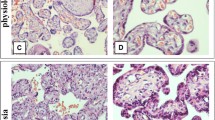Summary
In human foetal colon meconium corpuscles were observed in the colonic epithelium during the stage of secondary lumina development and enlargement.
Transmission electron microscopy of these specimens revealed inclusion bodies in the superficial and deeper layers of the epithelium. Many of the membrane-bounded inclusion bodies contained well-preserved organelles and some inclusions contained nuclear fragments. There was evidence of nuclear fragmentation with condensed chromatin arranged in crescentic caps. The ultrastructural observations are typical of apoptosis, a mode of cell death first described in 1972 by Kerr and colleagues.
Thus, meconium corpuscles are apoptotic bodies found as a result of the deletion of healthy normal cells during the reshaping and development of organs.
Similar content being viewed by others
References
Andersen H, Bierring F, Matthiessen M, Egeberg J, Bro-Rasmussen F (1964) On the nature of meconium corpuscles in human foetal intestinal epithelium: II. A cytochemical study. Acta Pathol Microbiol Scand 61:377–393
Behnke O (1963) Demonstration of acid phosphatase-containing granules and cytoplasmic bodies in the epithelium of foetal rat duodenum during certain stages of differentiation. J Cell Biol 18:251–265
Bell L, Williams L (1982) A scanning and transmission electron microscopical study of the morphogenesis of human colonic villi. Anat Embryol 165:437–455
Bierring F, Andersen H, Bro-Rasmussen F, Mathiesen M (1964) On the nature of the meconium corpuscles in human fetal intestinal epithelium. I. Electron microscopic studies. Acta Pathol Microbiol Scand 61:365–376
Glücksman A (1951) Cell deaths in normal vertebrate ontogeny. Biol Rev 26:59–86
Harmon B, Bell L, Williams L (1984) An ultrastructural study on the “meconium corpuscles” in rat foetal intestinal epithelium with particular reference to apoptosis. Anat Embryol 169:119–124
Helander HF (1973) Morphological studies on the development of the rat colonic mucosa. Acta Anat (Basel) 85:153–176
Hinchcliffe JR (1981) Cell death in embryogenesis. In: Brown ID, Lockshin RA (eds) Cell death in biology and pathology. Chapman & Hall London-New York
Iffy L, Jakobovitis A, Westlake W, Wingate M, Caterini H, Kanofsky P, Menduke H (1975) Early intrauterine development: 1. The rate of growth of caucasian embryos and fetuses between the 6th and 20th weeks of gestation. Pediatrics 56:173–186
Kerr JFR, Wyllie AH, Currie AR (1972) Apoptosis: a basic biological phenomenon with wide-ranging implications in tissue kinetics. Br J Cancer 26:239–257
Moxey PC, Trier JS (1979) Development of villus absorptive cells in the human fetal small intestine: a morphological and morphometric study. Anat Rec 195:463–482
Parat M (1922) Contribution a l'histo-physiologie des organes digestifs de l'embryon. C R Soc Biol (Paris) 87:1273–1275
Parat M (1924) Le méconium est-il un déchet. Bull Histol Appl 1:269–278
Patten BM (1968) Human embryology. 3rd ed. McGraw-Hill Book Co. New York, p 143
Reynolds ES (1963) The use of lead citrate at high pH as an electron opaque stain for electron microscopy. J Cell Biol 17:208–212
Ruebner BH, Kanayama R, Bronson RT, Blumenthal S (1974) Meconium corpuscles in intestinal epithelium of fetal and newborn primates. Arch Pathol 98:396–399
Saunders JW Jr (1966) Death in embryonic systems. Science, NY 154:604–612
Schmidt JE (1905) Beiträge zur normalen und pathologischen Histologie einiger Zellarten der Schleimhaut des menschlichen Darmkanales. Arch mikr Anat u Entwickl Ges 66:12–40
Tardieu, Robin (1857) Ann d'Hygiene. Cited by Schmidt (1905)
Tobeck A (1927) Über angeborene Verschlüsse (Atresien) des Darmrohres. Virchows Arch [Pathol Anat] 265:330–353
Trier JS, Moxey PC (1979) Morphogenesis of the small intestine during fetal development. In: Development of mammalian absorptive processes. Ciba Foundation Symposium No. 70 (New Series)
Wright NA (1981) The tissue kinetics of cell loss. In: Bowen ID, Lockshin RA (eds) Cell death in biology and pathology. Chapman & Hall London-New York
Wyllie AH (1981) Cell death: a new classification separating apoptosis from necrosis. In: Bowen ID, Lockshin RA (eds) Cell death in biology and pathology. Chapman & Hall London-New York
Wyllie AH, Kerr JFR, Currie AR (1980) Cell death: the singnificance of apoptosis. Int Rev Cytol 68:251–306
Author information
Authors and Affiliations
Rights and permissions
About this article
Cite this article
Williams, L., Bell, L. An ultrastructural study of meconium corpuscles in human foetal colon. Anat Embryol 171, 373–376 (1985). https://doi.org/10.1007/BF00347026
Accepted:
Issue Date:
DOI: https://doi.org/10.1007/BF00347026




